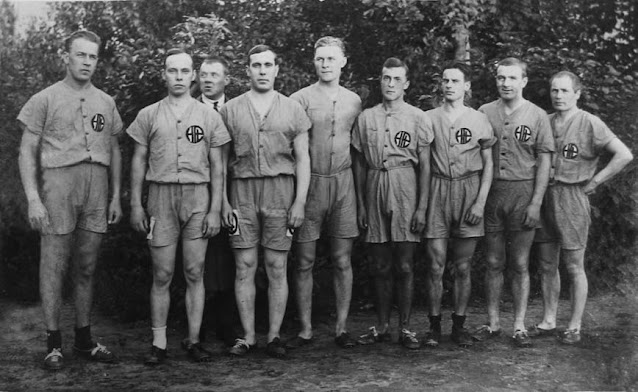100 years in the making - Part 1
 |
| The first Finnish Champions in 1922 - Helsingen Pallonlyöjat |
It was 100 years ago on 14th November 2020 when the first test match for pesäpallo was played in Kaisaniemi in Helsinki and we are now currently in the build up to the 100 year anniversary of the Finnish championship. In this post I take a quick look at the world then and now and how the sport and the world it is played in have changed, before pondering in the next post - what could a heritage game look like next year as part of the celebrations?
Welcome to 1920
At the time, there was very little to celebrate about - the world was recovering from the effects of the Great War, the Russian Civil war (which saw a lot of international intervention) and for Finland in particular, the Finnish Civil War. It was a desperate time for many and one aim for pesäpallo in particular was to help teach military tactics and skills in a recreational setting to help defend the country if threatened. This, amongst other things, was a key factor in defending Finland against the might of the Soviet forces during the Winter War.
1920 may seem like a completely different time to the problems that society faces now; however there are some striking similarities. 1920 marked the end of the influenza pandemic often referred to as the “Spanish Flu”, by November the US elected a new president, Warren Harding, on a promise of a “return to normalcy” after a turbulent era of division amongst ethnic groups. Also, in baseball, the Brooklyn Robins (later the LA Dodgers) were crowned National League champions.
The birth of the Finnish Championship
With the traditional game Pitkäpallo (Longball) still being played in 1921, pesis had never the less gathered in interest, after Lauri “Tahko” Pihkala had formally published the rules on 28th March 1921. Most of the summer of 1921 saw more trials and refinement of the rules and eventually saw players and fans alike flock to this new sport.
In 1922 pesis had already practically ousted Pitkäpallo as the bat and ball game of choice. With the sport now in practice in various areas of Finland, the Finnish Sports Journal published an invitation on 4th July 1922 to baseball teams to register for the Finnish championships. 7 teams answered the challenge and a tournament was held to determine the champion. The teams were:
HPL - Helsingin Pallonlyöjät
HelsRU - Helsingin Radiourheilijat
Ilves - Hämeenlinnan Ilves
Ikaal Sk - Ikaalisten Suojeluskunta
KaKa - Kauhajoen Karhu
Toij sk - Toijalan Suojeluskunta
VaVa - Vaasan Vasama
The finalists were HPL and Toijalan and the final was held on 17th September 1922, where HPL won 18-9 and were crowned the first Finnish Champions. In later years the competition grew and became an annual fixture in the sporting calendar.
The sport today
As pesis grows, the game changes (sometimes subtly and sometimes significantly). For most of the sport’s history pesis followed baseball’s structure of 9 innings but this changed in 1994. Today, the game centres around 2 periods of 4 innings, with an extra inning and a scoring contest if the game remains tied. In addition, in 1986, pesis introduced the “joker” as a new tactical element. Today each team is allowed 3 jokers in each inning and each player has a specific role that they excel at, making pesäpallo one of the most exciting, fast paced and tactical bat and ball sports in the world.
In 2019 the Pesäpallo World Cup was held in Pune, India and was the most competitive international tournament yet. The Asian market is booming and more and more people are interested in the sport outside of Finland. In 2020 pesäpallo was one of the few sports that managed to play a (mostly) unaffected season and attracted more attention internationally.
The future
As fans of cricket have seen in recent years, sport is not defined by the countries that play it, but the countries that play it help to define the sport. Cricket has grown significantly internationally and the styles of play, tactics and culture around the game are enriched and help to shape the future of the sport. Cricket Finland for example is a significant part of the developing future of the sport and the spirit of the Finnish fast paced exciting sport is injected into the way that the games are formatted.
But what about pesäpallo? Well, there are exciting developments in India, Bangladesh and Nepal, not to mention a growing strength for he sport in Switzerland who have a highly competitive national league. Enquiries on pesis still come from far and wide, even podcast co-host Mikko Pirhonen is fielding questions from curious followers of the sport from the US. But as we approach the height of celebrations in 2022, the international scene is still very small. As Juha “Upi” Antikainen said on our August podcast: we have to stop being so afraid to say how good this sport is.
Finland does not promote its national sport very well, partly due to the humility of its people. But it is time to start spreading the word for pesäpallo in a big way - if fans of the sport like me want to make the 100 year celebrations spectacular and bring new audiences to the sport in order to reach its true potential, we cannot be silent any longer. In an age where anything can be found on the internet, lets start getting some more amazing and accessible content out there.
Photograph
Cover - (c) Pesäpalloliito 2020



Comments
Post a Comment